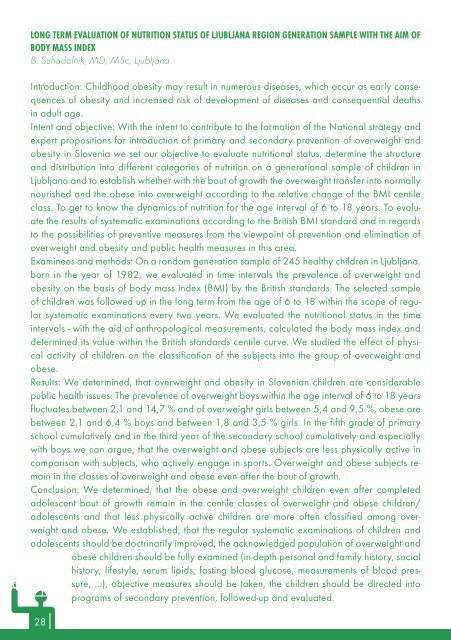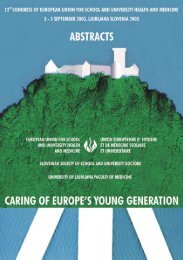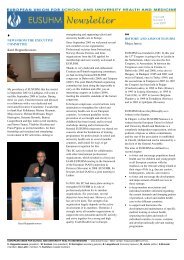abstract ok.indd - eusuhm
abstract ok.indd - eusuhm
abstract ok.indd - eusuhm
Create successful ePaper yourself
Turn your PDF publications into a flip-book with our unique Google optimized e-Paper software.
LONG TERM EVALUATION OF NUTRITION STATUS OF LJUBLJANA REGION GENERATION SAMPLE WITH THE AIM OF<br />
BODY MASS INDEX<br />
B. Suhadolnik, MD, MSc, Ljubljana<br />
Introduction: Childhood obesity may result in numerous diseases, which occur as early consequences<br />
of obesity and increased risk of development of diseases and consequential deaths<br />
in adult age.<br />
Intent and objective: With the intent to contribute to the formation of the National strategy and<br />
expert propositions for introduction of primary and secondary prevention of overweight and<br />
obesity in Slovenia we set our objective to evaluate nutritional status, determine the structure<br />
and distribution into different categories of nutrition on a generational sample of children in<br />
Ljubljana and to establish whether with the bout of growth the overweight transfer into normally<br />
nourished and the obese into overweight according to the relative change of the BMI centile<br />
class. To get to know the dynamics of nutrition for the age interval of 6 to 18 years. To evaluate<br />
the results of systematic examinations according to the British BMI standard and in regards<br />
to the possibilities of preventive measures from the viewpoint of prevention and elimination of<br />
overweight and obesity and public health measures in this area.<br />
Examinees and methods: On a random generation sample of 245 healthy children in Ljubljana,<br />
born in the year of 1982, we evaluated in time intervals the prevalence of overweight and<br />
obesity on the basis of body mass index (BMI) by the British standards. The selected sample<br />
of children was followed up in the long term from the age of 6 to 18 within the scope of regular<br />
systematic examinations every two years. We evaluated the nutritional status in the time<br />
intervals - with the aid of anthropological measurements, calculated the body mass index and<br />
determined its value within the British standards centile curve. We studied the effect of physical<br />
activity of children on the classification of the subjects into the group of overweight and<br />
obese.<br />
Results: We determined, that overweight and obesity in Slovenian children are considerable<br />
public health issues. The prevalence of overweight boys within the age interval of 6 to 18 years<br />
fluctuates between 2,1 and 14,7 % and of overweight girls between 5,4 and 9,5 %, obese are<br />
between 2,1 and 6,4 % boys and between 1,8 and 3,5 % girls. In the fifth grade of primary<br />
school cumulatively and in the third year of the secondary school cumulatively and especially<br />
with boys we can argue, that the overweight and obese subjects are less physically active in<br />
comparison with subjects, who actively engage in sports. Overweight and obese subjects remain<br />
in the classes of overweight and obese even after the bout of growth.<br />
Conclusion: We determined, that the obese and overweight children even after completed<br />
adolescent bout of growth remain in the centile classes of overweight and obese children/<br />
adolescents and that less physically active children are more often classified among overweight<br />
and obese. We established, that the regular systematic examinations of children and<br />
adolescents should be doctrinarily improved, the acknowledged population of overweight and<br />
obese children should be fully examined (in-depth personal and family history, social<br />
history, lifestyle, serum lipids, fasting blood glucose, measurements of blood pressure,<br />
...), objective measures should be taken, the children should be directed into<br />
programs of secondary prevention, followed-up and evaluated.<br />
28




